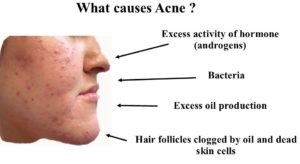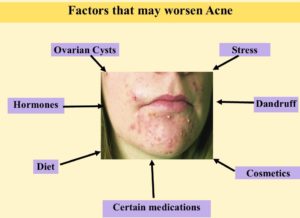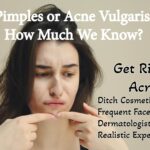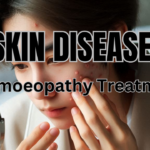Acne – The common skin problem
Acne is the most common skin problem especially in young adults, though it is more common in females, males are not spared either.


It commonly occurs during puberty and adolescence, when the sebaceous glands (oil secreting glands of skin), are the most active, but it can occur at any age. Though not dangerous, it may leave behind skin scars.
A recent data says that 80% of people in the age group of 11-30 years have acne out break at least once. This doesn’t mean that adults may not get acne; they are also prone to it. Some women who do not get acne in their teens may get it in their adult hood.
Acne symptoms
Acne signs and symptoms vary depending on the severity of the condition:
• Whiteheads (closed plugged pores)
• Blackheads (open plugged pores)
• Small red, tender bumps (papules)
• Pimples (pustules), which are papules with pus at their tips
• Large, solid, painful lumps beneath the surface of the skin (nodules)
• Painful, pus-filled lumps beneath the surface of the skin (cystic lesions)
Types of Acne
- Acne Vulgaris: Acne Vulgaris is the medical name for common acne – the presence of blackheads, whiteheads, and other types of pimples on the skin. The most common spots for breakouts are the face, chest, shoulders, and back.
- Comedones: A comedo, or basic acne lesion, is a hair follicle that has become clogged with oil and dead skin cells. Comedones (the plural of comedo) can develop into bumps called whiteheads and blackheads. Products that may trigger comedones are called “comedogenic.” Makeup labeled “noncomedogenic” is less likely to clog pores and contribute to acne.
- Blackheads: Blackheads are comedones that are open at the surface of the skin. They are filled with excess oil and dead skin cells. It’s not dirt that causes the comedone to turn black. The black hue results from the irregular reflection of light coming from clogged hair follicles.
- Whiteheads: Comedones that stay closed at the surface of the skin are called whiteheads. This happens when oil and skin cells prevent a clogged hair follicle from opening. Many of the same over-the-counter medicines that treat blackheads are also effective against whiteheads.
- Papules: Papules are comedones that become inflamed, forming small red or pink bumps on the skin. This type of pimple may be sensitive to the touch. Picking or squeezing can make the inflammation worse and may lead to scarring. A large number of papules may indicate moderate to severe acne.
- Pustules: Pustules are another kind of inflamed pimple. They resemble a whitehead with a red ring around the bump. The bump is typically filled with white or yellow pus. Avoid picking or squeezing pustules. Picking can cause scars or dark spots to develop on the skin.
- Nodules: Nodules are large, inflamed bumps that feel firm to the touch. They develop deep within the skin and are often painful.
- Cysts: Cysts are large, pus-filled lesions that look similar to boils. Like nodules, cysts can be painful and should be treated by a dermatologist. People who develop nodules and cysts are usually considered to have a more severe form of acne.


Four main factors cause acne:
• Excess oil production
• Hair follicles clogged by oil and dead skin cells
• Bacteria
• Excess activity of hormone (androgens)
Acne typically appears on your face, forehead, chest, upper back and shoulders because these areas of skin have the most oil (sebaceous) glands. Hair follicles are connected to oil glands.
The follicle wall may bulge and produce a whitehead. Or the plug may be open to the surface and darken, causing a blackhead. A blackhead may look like dirt stuck in pores. But actually the pore is filled with bacteria and oil, which turns brown when exposed to the air.
Pimples are raised red spots with a white center that develop when blocked hair follicles become inflamed or infected with bacteria. Blockages and inflammation that develop deep inside hair follicles produce cyst like lumps beneath the surface of the skin. Other pores in your skin, which are the openings of the sweat glands, aren’t usually involved in acne.
Factors that may worsen acne
These factors can trigger or aggravate acne:


- Hormones. Androgens are hormones that increase in boys and girls during puberty and cause the sebaceous glands to enlarge and produce more sebum. Hormonal changes related to pregnancy and the use of oral contraceptives also can affect sebum production. Low amounts of androgens circulating in the blood of women and can worsen acne.
- Ovarian Cysts. In females, acne can occur as one of the key manifestations of polycystic ovarian syndrome (PCOS) along with facial hair growth, weight gain, irregular menstrual cycle etc.
- Certain medications. Examples include drugs containing corticosteroids, testosterone or lithium.
- Diet. Studies indicate that certain dietary factors, including skim milk and carbohydrate-rich foods — such as bread, bagels and chips — may worsen acne. Chocolate has long been suspected of making acne worse.
- Dandruff. People suffering from dandruff tend to develop acne especially on shoulders, chest & fore head.
- Cosmetics. Creams, lotions, oil based make up products can cause acne cosmetica
- Stress. Stress can make acne worse.
Risk factors
Risk factors for acne include:
- Age. People of all ages can get acne, but it’s most common in teenagers.
- Hormonal changes. Such changes are common in teenagers, women and girls, and people using certain medications, including those containing corticosteroids, androgens or lithium.
- Family history. Genetics plays a role in acne. If both parents had acne, child is likely to develop it, too.
- Greasy or oily substances. You may develop acne where your skin comes into contact with oily lotions and creams or with grease in a work area, such as a kitchen with fry vats.
- Friction or pressure on your skin. This can be caused by items such as telephones, cell phones, helmets, tight collars and backpacks.
- Stress. Stress doesn’t cause acne, but if you have acne already, it may make it worse.
Acne Treatment
Homeopathy Treatment for Acne
Homeopathy has proven to be very good and effective in the treatment of acne. Rightly chosen homeo remedies along with changes in patient’s life style can provide a better solution for acne. Acne is not just considered as a mere skin ailment, the causes lie much deeper.
There are hundreds of homeo remedies indicated in acne few examples are given below to emphasize the holistic approach through homeopathy in the treatment of acne
• Pulsatilla is remedy in treating acne in girls during puberty, acne with irregular menstrual cycle, useful in people in whom acne is triggered by eating fat rich, oil rich foods like condiments, bakery foods etc. other points in selecting this remedy is that the person needing this remedy is usually sensitive emotionally, mild natured.
• Nat.Mur: Is very effective remedy in people having acne with itching & oily skin. Other points being increased thirst, excessive sweating, and intolerance to heat of sun.
• Silicea is indicated when there is acne filled with pus & cystic acne. Acne in people who also suffer with constipation, their wound and injuries suppurate (pus formation) easily and don’t heal fast. Other points on which this remedy is prescribed are where the person is very sensitive to cold weather, has profuse sweating etc..:
• Kali.Brom. is the remedy for acne in puberty, acne having reddish appearance and for acne leaving ugly scars.
• Ant.crud. is prescribed when acne either due to or associated with gastric problems, like indigestion, eating sour foods, like pickles etc.
• Sulphur is very effective in acne with lot of itching. It is also good for people with acne who have dry, dirty looking skin & their skin complaints become worse by bathing or washing.
There are many such effective Homeo remedies which if properly chosen can tackle any kind of acne without causing any harm to the patient, it helps not only in curing acne but also prevents its recurrence.


Dr Tejaswi K P
Reader, Dept of Surgery
Bhagwan Buddha Homeo Medical College,
Mallathalli, Bengaluru
Consultant – Surabhi Homeo Clinic
Vidyaranyapura, Bengaluru 560097
Mob: 9731133819











